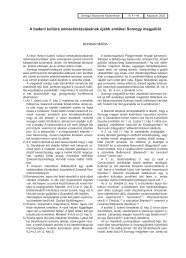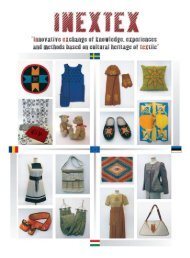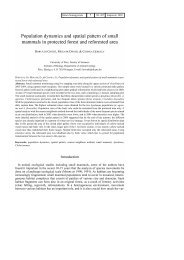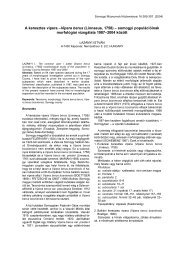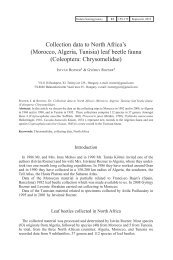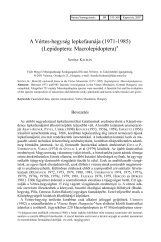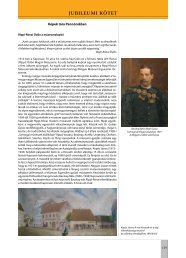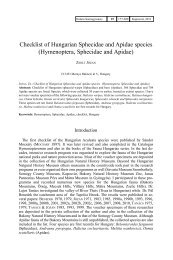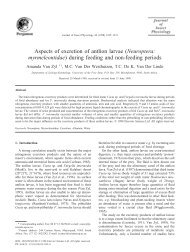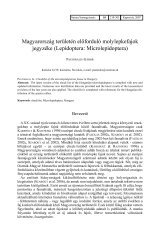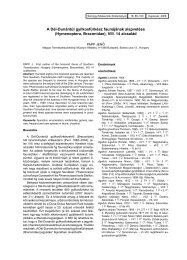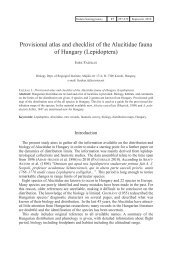Contribution to the ant-lion and owl-fly fauna of Madagascar with ...
Contribution to the ant-lion and owl-fly fauna of Madagascar with ...
Contribution to the ant-lion and owl-fly fauna of Madagascar with ...
You also want an ePaper? Increase the reach of your titles
YUMPU automatically turns print PDFs into web optimized ePapers that Google loves.
114<br />
Myrmeleontinae Latreille, 1802<br />
nat u r a somogyiensis<br />
Fig. 2: Habitus <strong>of</strong> female <strong>of</strong> Syngenes alluaudi (Weele, 1909)<br />
Syngenes alluaudi (Weele, 1909) comb. n. (Fig. 2.)<br />
Ac<strong>ant</strong>haclisis alluaudi Weele, 1909 – Weele 1909b (Odescr), Klapalek 1913 (Dist), Fraser 1951a (Chlist, K).<br />
Centroclisis alluaudi (Weele, 1909) – Penny 2003 (Chlist), Stange 2004 (Mon, Comb).<br />
Sogra alluaudi (Weele, 1909) – Navás 1912b (Comb), Whitting<strong>to</strong>n 2002 (Dist).<br />
Material examined:<br />
In Coll. SCMK: Prov. Toliara, Ifaty 24 km N Tulear 30m, 10.-17.12.2003. 4♂ 24♀ leg. S. Murzin & A.<br />
Shamaev; Prov. Toliara, Ifaty 20 km N Tulear 30m, 10.-27.12.2003. 8♂ 62♀ leg. S. Murzin & A. Shamaev in<br />
alcohol.<br />
In Coll. USMB: Prov. Toliara, Toliara env., 23-27.11.1996, 1♂ 1♀ leg. J. S<strong>to</strong>larczyk (det. L. Ábrahám) (USMB<br />
5858/723; USMB 5858/733).<br />
Comment: A large series <strong>of</strong> specimens was investigated <strong>and</strong> signific<strong>ant</strong> morphological<br />
differences were found especially in <strong>the</strong> pigmentation <strong>of</strong> fore wing. Many specimens<br />
have a dark spot above <strong>the</strong> hind margin at <strong>the</strong> joint <strong>of</strong> Cu2 <strong>and</strong> CuP+A1 on <strong>the</strong> fore wing.<br />
The cross-veins are simple in <strong>the</strong> one-fourth part <strong>of</strong> <strong>the</strong> costal area but <strong>the</strong> distal part is<br />
subequally divided <strong>with</strong> two-row cells; <strong>the</strong>re are no bifurcated cross-veins except for <strong>the</strong><br />
area right before <strong>the</strong> pterostigma, which are characteristic for <strong>the</strong> o<strong>the</strong>r species <strong>of</strong> <strong>the</strong><br />
genus, <strong>to</strong>o. There is less pubescence on legs than that <strong>of</strong> Centroclisis sp. Tibial spurs<br />
curve smoothly <strong>with</strong>out inward processus. Male ec<strong>to</strong>proct is long, straight <strong>and</strong> <strong>with</strong> a<br />
tapered apex. stange (2004) assigned it <strong>to</strong> Centroclisis but that was a wrong combination.<br />
The taxonomical status <strong>of</strong> African Syngenes Kolbe, 1897 species need <strong>to</strong> be revised<br />
since <strong>the</strong> validity <strong>of</strong> S. inquinatus (Gerstaecker, 1885), S. dolichocerus Navás, 1914, S.<br />
maritimus Needham, 1913 is doubtful. S. longicornis (Rambur, 1842) seems <strong>to</strong> be a<br />
widespread species in <strong>the</strong> Central <strong>and</strong> Sou<strong>the</strong>rn part <strong>of</strong> Africa (stange 2004) <strong>and</strong> many<br />
authors (WeeLe 1907, esben-Petersen 1916, 1920, navÁs 1935, Fraser 1951,



